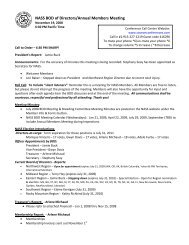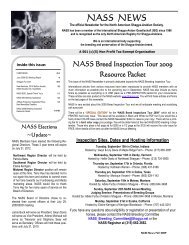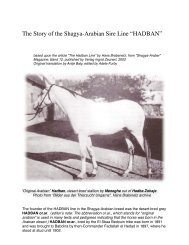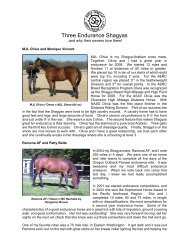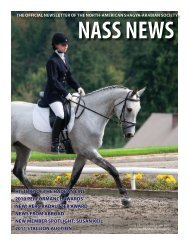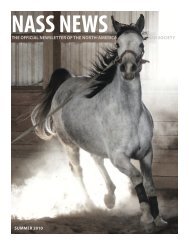NASS 2012 Breeding Inspection Tour Resource Packet
NASS 2012 Breeding Inspection Tour Resource Packet
NASS 2012 Breeding Inspection Tour Resource Packet
You also want an ePaper? Increase the reach of your titles
YUMPU automatically turns print PDFs into web optimized ePapers that Google loves.
haviour, a mare feminine. Intermediate types are seldom satisfactory in their genetic<br />
transmission.<br />
ad 2) Head: the head should reflect the personality of the horse and show Arab feat-<br />
ures. It should not appear to be large and heavy. The profile may be slightly dished<br />
or straight. Roman noses are not welcome. Be careful that the teeth meet normally!<br />
(Not under- or overshot)<br />
ad 3) Neck: a long, noble, arched riding-horse neck with slender throat is one of the<br />
most pleasing points of the horse. Harmony and rideability of all horses are diminish-<br />
ed by a heavy neck, short thick throat, ewe-neck or by a neck set on too low. Points<br />
awarded in such cases cannot exceed "sufficient".<br />
ad 4) Body: the correct judgement of the horse's frame, i.e. the relationship of height<br />
to length of body is an important prerequisite for points awarded here.<br />
The frame of the horse is represented by the two horizontal lines over withers and<br />
the ground and two perpendicular lines along point of buttocks and point of shoulder.<br />
Height is height':of withers as measured with a yardstick. Length is the distance from<br />
point of buttocks to point of shoulder.<br />
Shagya Arabs between 14.3 and 15 hands are considered small, between 15 and<br />
15.2 hands medium and between 15.2 and 16 hands and more as large. The frame<br />
should always be longer than tall, i.e. a rectangle. The square frame (as long as tall)<br />
is not welcome; it is mostly combined with a stiff back and reduced ability at the walk<br />
and canter. If the horse is too long in the back this impedes carriage, balance, and<br />
drive from the hind legs.<br />
The large-framed Shagya-Arab is preferred by the market. This means at least medium<br />
height combined with rectangular frame. Depth of girth and barrel should harmonise<br />
with the frame. From the front the chest must be deep and broad. Muscle is<br />
ideal if from this point of view the elbow joints are further apart than the shoulder<br />
joints.<br />
A similar yardstick may be applied to the musculature of the hindquarters. The<br />
"britches" should broaden, as viewed from behind, from the point of the hip towards<br />
the stifle. The musculature of the inner and outer second thigh from stifle to hock is<br />
also important for the drive from the hindquarters.<br />
ad 4) Topline: extends from the ears to the tip of the tail. Should have the shape and<br />
length required of both riding and carriage horses at their best. High carriage and<br />
good length of lightly arched neck, withers long and sufficiently high, long croup (no<br />
goose rump), tail carried high and gaily - the pennant of the prophet!<br />
ad 5) Legs: cannon-bone must bear relation to the substance of the horse. The joints<br />
and their extensions - elbows, back of knee, and point of hock - must be well defined<br />
and strong. The legs must not be tied-in below the knee or under the hock. The hock<br />
must be neither too short nor too narrow. The forelegs should not be X-legged as<br />
seen from the front nor standing over or back-at-the-knee when viewed from the



